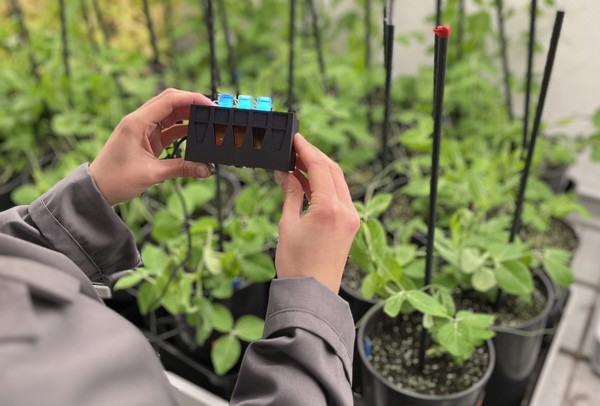Being able to test the greenhouse and crop for ToBRFV yourself is already a big win for growers. Especially at a time of high virus threat. What is new is that growers now even have a reliable result within an hour. Even testing just a few plants is now possible with a 'light test' being developed by Spark Radar. The market launch will follow at the end of this year.
"Growers asked us for a test like this, so they can test one or a few plants in a very targeted way, but with the specificity and reliability applicable to our test," Bas Rutjens says. Together with associate Rogier van der Voort, he founded Spark Genetics, from which Spark Radar for on-site plant pathogen testing emerged.

Rogier and Bas
Testing a few plants
The first kit, focused on ToBRFV, has been active in horticulture since late last year. "With this, growers can test 60 plants and now even 100 at a time. But in the case of a clearly symptomatic plant, growers don't want to use our regular test. The grower then only wants to test one or a few plants for confirmation."
Spark Radar now offers an alternative to the existing antigen test. "An antigen test is less sensitive and suffers from false positive or false negative reports. Our system signals only if the genetic material of a specific pathogen is found in the sample. We actually work with a greatly scaled-down version of the regular test without sacrificing performance."
That performance was validated this year by an independent Belgian research institute. "There, our test was compared with the well-known Q-PCR test. The results show that our test is comparable in terms of sensitivity and does not provide a false-positive signal."
Plant prodding
With the 'light test,' a crucial step is how the user arrives at a good, reliable signal from a small amount of material. "Plants are known for the presence of all kinds of substances that interfere with enzymatic reactions, such as PCR tests. You will, therefore, almost always have to perform purification steps. Our tests also contain enzymes that are sensitive to these plant components. Especially for the regular test with its high sensitivity, purification is a must. For the 'light test,' we take a different approach."
For the 'light test,' the user does this during sampling. "In this test, unlike the regular test, the grower pricks the plant. Taking leaf material is not necessary. After pricking, the user transfers the material directly to the test solution."
Addition to existing test
After the introduction of the regular ToBRFV test for leaf material, a test for seeds, water, and a swab test for surfaces soon followed. These tests were further optimized during the season. "It is precisely here that you want to observe low virus levels in larger volumes of water or plant material. For water, we now know from scientific studies that ToBRFV can leak through the root tips into the substrate mats and then back into the drain water. You can test that water with our regular test."
The essence of the regular test remains early detection of the virus. "Where we see the power of the existing test confirmed is with growers who start clean at the beginning of cultivation. If they then routinely test and still find the virus, they can act quickly. The 'light test' complements this to test very targeted a few suspect plants later in the season."

Cucumber green mottle mosaic virus
Bas and Rogier's initial idea was to develop a modular test. ToBRFV turned out to be the most pressing problem for much of the market. Meanwhile, a test similar to the regular ToBRFV test has also been developed for cucumber green mottle mosaic virus (CGMMV). "For us, the addition of CGMMV is confirmation of our initial idea," he says.
The test kit for cucumber green mottle mosaic virus works in the same way, with a magnetic rack and a detection rack. "By using the magnetic rack, we pull the virus out of the collected material, so to speak. It helps ensure the high sensitivity of our test."
The kit for CGMMV is already on the market and used in the Netherlands and France. "So far, with good results. In terms of feedback to us, it does help that CGMMV does not have Q status, as ToBRFV does in Europe."
Bacteria also possible
Spark Radar's modular test will eventually be able to be used for even more viruses, as well as bacteria. "Our test would work in the same way for this. Active bacteria make RNA continuously. As with viruses, we extract a specific RNA from the collected material for testing. We only need to adjust the reagents on another virus or bacteria."
For more information:
Rogier van der Voort 
Spark Radar
Padualaan 8
3584 CH, Utrecht
[email protected]
[email protected]
www.sparkradar.bio
